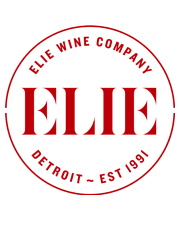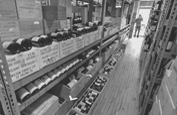Classic Barolo from the Outstanding 2010 Vintage
Alessandro and Gian Natale Fantino “Riserva” Cascina Dardi Bussia (Barolo 2010)
~$53/bottle SOLD OUT
Barolo is a perfect marriage between a grape and a place. Indeed, the Nebbiolo variety – named after the fogs or “nebbia” that are normal during its late October harvest – thrives only in certain places, most notably in Italy’s Piedmont region around the town of Alba and through the hills known as Langhe where Barolo is king. By most accounts, 2010 was an outstanding year for Barolo and that is clearly reflected in Fantino’s “Riserva” with its dense fruit, silky tannins, and long finish.
 60+ year old vines are fermented for 30-35 days in stainless steel tank and then aged in large oak barrels for five years and then bottle for 12 months before release. Eight years after this grand vintage the wine is at a point where it is already marvelously expressive with electrifying aromas of rose petals and black cherry over hints of licorice and marzipan. The ethereal brick red color belies a mouthful of concentrated fruit that leads to a mid palate of deeply polished tannins that exit with an epic mineral flourish. Drink it now and over the next 15 years.
60+ year old vines are fermented for 30-35 days in stainless steel tank and then aged in large oak barrels for five years and then bottle for 12 months before release. Eight years after this grand vintage the wine is at a point where it is already marvelously expressive with electrifying aromas of rose petals and black cherry over hints of licorice and marzipan. The ethereal brick red color belies a mouthful of concentrated fruit that leads to a mid palate of deeply polished tannins that exit with an epic mineral flourish. Drink it now and over the next 15 years.
For a large part of his career, Alessandro Fantino was part owner and made the wines for the renowned Cantina Bartolo Mascarello. In 1998 he sold his portion of the winery to Bartolo’s daughter Maria-Teresa and dedicated himself to helping his brother run their family estate full-time.
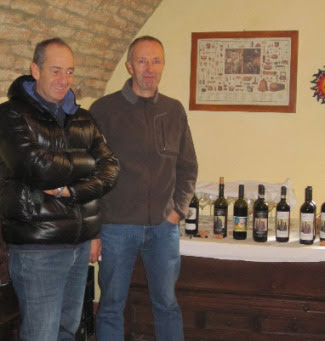 Now both Alessandro and Gian Natale Fantino are creating superb wines out of their tiny, garage-sized winery in the old town center of Monforte d’Alba. They own a scant 20 acres exclusively on the hillside of “Dardi” with perfect southeastern exposure in the heart of the historic Bussia cru, one of Barolo’s most renowned areas for producing wines of finesse and longevity.
Now both Alessandro and Gian Natale Fantino are creating superb wines out of their tiny, garage-sized winery in the old town center of Monforte d’Alba. They own a scant 20 acres exclusively on the hillside of “Dardi” with perfect southeastern exposure in the heart of the historic Bussia cru, one of Barolo’s most renowned areas for producing wines of finesse and longevity.
Allesandro honed his craft over the 18 years he worked with Bartolo Mascarello and still holds on to much of what he learned from the old master. Like long, uncomplicated fermentations followed by extended aging in large, neutral barrels in which the wines are allowed to mature and soften.
More Wines from Alessandro and Gian Natale Fantino

Barbera d’Alba Superiore (2016)
Special Price: $113/6-pack (~$19/bottle) SOLD OUT
Alessandro is on a quest for fragrance and elegance over power yet this may be the sappiest Barbera d’Alba under $20 that is locally available. It shows high tones of perky flowers and low tones of macerated red fruit. A sip is a balance of ripe and juicy, with a lengthy finish that shows its real estate pedigree. This is a wine that clearly states its from the Piedmont.
The wine is produced from 60+ year old vines that grow on the same hillsides as the Nebbiolo vines that make up their Barolo. The fruit is always hand-harvested and then hand-sorted at the winery prior to fermentation with native yeasts. It then ages 18 months in stainless steel and another 3 months in bottle prior to release.

Barolo Chinato
$49/bottle
The Fantino brothers are specialists with Barolo Chinato, a traditional Piemontese wine used as a digestif that is disappearing from production. Barolo wine is first aged in large oak barrels for 4 years. It is then fortified and blended with the family’s recipe of spices: China Calissaio, Bergamotto, Arancio, Mandrino, Vanilia, Cannella, Genziana, Chiudi di Garofano, Cardomomo, Assenzio (absinthe), and more. After blending the wine is aged in stainless steel tanks for 6 months and bottle for 3 months before release. Expect a deliciously aromatized Barolo, fascinating and complex with a long, herbal finish.
- - -
Posted on 2018.04.04 in Saturday Sips Wines, Piedmont, Italy | Read more...
The Champagne Society – April 2018 Selection: Champagne De Sousa
Champagne De Sousa “Cuvée des Caudalies” Brut Blanc de Blancs (Grand Cru)
Price for The Champagne Society members: $84
The April 2018 selection for The Champagne Society is Champagne De Sousa “Cuvée des Caudalies” Brut Blanc de Blancs. The f ruit for this cuvée is always selected from their oldest vines over 50 years old planted in Grand Cru villages of the Côte des Blancs — the source for many vintage Champagnes and prestige cuvées from the large Champagne houses. The wine is vinified entirely in oak barrels (a small portion of new oak) and then aged and assembled with 50% reserve wine from a solera method of wines from the past 12 vintages. The result is a wine of remarkable purity. Beyond the multitude of mouth-filling white fruits is an autumnal parade of complex flavors and aromatics to conclude with the hallmark finish of salty, Côte des Blancs chalk.
ruit for this cuvée is always selected from their oldest vines over 50 years old planted in Grand Cru villages of the Côte des Blancs — the source for many vintage Champagnes and prestige cuvées from the large Champagne houses. The wine is vinified entirely in oak barrels (a small portion of new oak) and then aged and assembled with 50% reserve wine from a solera method of wines from the past 12 vintages. The result is a wine of remarkable purity. Beyond the multitude of mouth-filling white fruits is an autumnal parade of complex flavors and aromatics to conclude with the hallmark finish of salty, Côte des Blancs chalk.
The term “Caudalie” denotes the persistence of the aromatic expression of a wine’s finish measured in seconds: 1 Caudalie = 0.92 seconds. Count the many Caudalies as you drink this exceptional Champagne.
Champagne De Sousa has risen to a rightful place among Champagne‘s greatest producers under Erick De Sousa’s visionary guidance. Over almost 30 years, Erick has refined the best of traditional thinking and progressive new methods to revitalize, transform and grow his estate to become one of the finest in the Côte des Blancs. His vineyard holdings consist of 42 plots spanning close to 24 acres, including over six acres of coveted old vines in Avize, Cramant, and Oger.
In his own words, Erick ‘lives in the rhythm of the vines’ and regards his work in the vineyards as the key to the quality of the grapes. To him, biodynamic viticulture is about equipping his old vines to capture minerality, ‘to encourage the vine to draw deeply the trace elements specific to each terroir and provide different characteristics to each cuvée.
He his now ably assisted by his two daughters, Charlotte and Julie, and son, Valentin, who have all completed degrees at the local wine school and have important roles in the family business, ensuring we’ll have access to these masterfully grown and crafted wines for many years to come.
Small production and highly allocated, we had just enough of this wine to supply one bottle to each of the members of The Champagne Society. Unfortunately there are no more available at this time.

- - -
Posted on 2018.04.01 in France, The Champagne Society, Champagne | Read more...
Righteous Syrah from Hallowed Ground in the Northern Rhône
Domaine Combier Crozes-Hermitage 2015
Special Price: $210/6-pack (~$35/bottle)
A great winemaker is first and foremost a fruit farmer. So perhaps it is no surprise that Maurice Combier has channeled his knowledge of organic fruit farming to produce pure and elegant wines with his son Laurent. It was in the early 1960s that Maurice purchased property in Pont de l’Isère – about a 10 minute drive south from the slopes of Hermitage – for the purpose of growing peaches and apricots, as well as grapes for the local cooperative in Tain l’Hermitage. A decade later, while most of the farming world was reveling in newly discovered synthetic fertilizers, Maurice was pioneering organic cultivation. At the time organics were practically unheard of and soon locals gave him the moniker “Maurice le Fou” or Crazy Maurice.
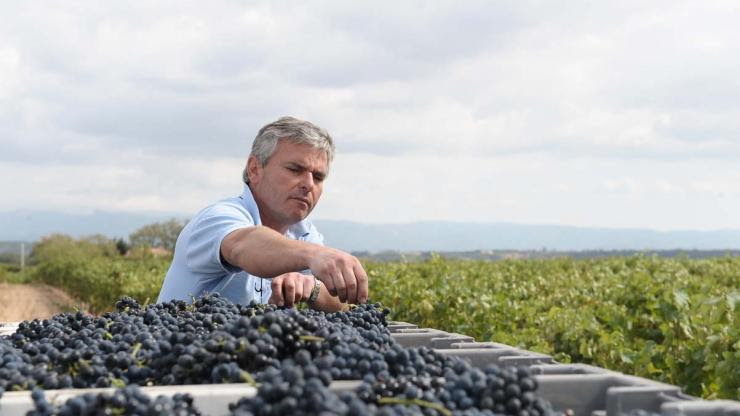 After Maurice’s first son Laurent dove into the study of viticulture and agriculture in Orange, and completed apprenticeships in Châteauneuf-du-Pape and Domaine d’Ott in Provence, the two decided to set off on their own in 1989. They established their own fruit brand called Combier, whose organic peaches and apricots are available throughout much of France, and also began producing wine from vineyards surrounding their house. Over the years, Laurent expanded the cellar, eventually constructing an underground chai where the wines are vinified and matured. Today, Laurent is fully in charge and the Combier domaine comprises close to 50 acres of vines in some of Northern Rhône’s top climats. Apparently not one for a quiet life, Laurent also has a 32 acre project in Priorat, Spain.
After Maurice’s first son Laurent dove into the study of viticulture and agriculture in Orange, and completed apprenticeships in Châteauneuf-du-Pape and Domaine d’Ott in Provence, the two decided to set off on their own in 1989. They established their own fruit brand called Combier, whose organic peaches and apricots are available throughout much of France, and also began producing wine from vineyards surrounding their house. Over the years, Laurent expanded the cellar, eventually constructing an underground chai where the wines are vinified and matured. Today, Laurent is fully in charge and the Combier domaine comprises close to 50 acres of vines in some of Northern Rhône’s top climats. Apparently not one for a quiet life, Laurent also has a 32 acre project in Priorat, Spain.
There is nothing short of fervent frothing when it comes to the 2015 vintage in Northern Rhône. According to most everyone concerned the weather was perfection: sunshine, rain, wind, and cool nights all fell upon the landscape exactly when required. In general the 2015 Northern Rhône wines have flawless balance, with the top wines likely developing into classics after decades of cellaring.
 The fruit for the Domaine Combier Crozes-Hermitage comes from parcels in and around Pont de l’Isère. The parcels reflect much of the terroir of Crozes-Hermitage, with sites composed of sandy soil with some granite, a site covered in small, round stones, and another site that is predominantly silt. Fruit is harvested by hand and yields are low. The wine matures for 12 months in barrels that have previously seen two or three wines. Minimal sulphur is added and filtering is gentle.
The fruit for the Domaine Combier Crozes-Hermitage comes from parcels in and around Pont de l’Isère. The parcels reflect much of the terroir of Crozes-Hermitage, with sites composed of sandy soil with some granite, a site covered in small, round stones, and another site that is predominantly silt. Fruit is harvested by hand and yields are low. The wine matures for 12 months in barrels that have previously seen two or three wines. Minimal sulphur is added and filtering is gentle.
The first whiff of a glass is that telltale Northern Rhône Syrah scent of red meat and flowers. It’s a voluptuous set of aromatics over more nuanced shades of tarragon and sun-warmed terracotta. With time the scent of ripe berry fruits emerge. A sip is pure, spiced loganberry that slowly uncoils to a lengthy finish of light roast espresso. For an intoxicating patio dinner pairing fire up the (lump charcoal) grill and throw on the kebabs.
Domaine Combier “Clos des Grives” (Crozes-Hermitage 2015)
Special Price: ~$67/bottle
 “Clos des Grives” is the top cuvée from Domaine Combier. The “Clos” is a single parcel enclosed by a hedge that is located just east of the domaine’s cellars and neighbors the property of legendary winemaker Alain Graillot. Over eleven acres, rich with red clay, chalk, and alluvial stones, are planted to Syrah vines that were planted over 60 years ago. Yields are shockingly small, less even than what is allowed in Burgundy’s Grands Crus. Maturation takes place in oak barrels, generally with about 25% of the barrels being new. Minimal sulphur is added and filtering is gentle.
“Clos des Grives” is the top cuvée from Domaine Combier. The “Clos” is a single parcel enclosed by a hedge that is located just east of the domaine’s cellars and neighbors the property of legendary winemaker Alain Graillot. Over eleven acres, rich with red clay, chalk, and alluvial stones, are planted to Syrah vines that were planted over 60 years ago. Yields are shockingly small, less even than what is allowed in Burgundy’s Grands Crus. Maturation takes place in oak barrels, generally with about 25% of the barrels being new. Minimal sulphur is added and filtering is gentle.
Consider the previous tasting note for the Domaine Combier Crozes-Hermitage, plug it into an amplifier, and then turn it up to eleven. Throw some dark chocolate on the finish. That is “Clos des Grives.” A glass is jammed with elegant, concentrated fruit and spicy, animal classicism. From nose to tail a sip is dense and filled with energy. We expect this wine to flesh out even more, both aromatically and on the palate, with cellar development. Pair with well-marbled red meat, simply prepared and seasoned.
- - -
Posted on 2018.03.28 in France, Saturday Sips Wines, Northern Rhone | Read more...
Bright & Pure Sardinian Red
Vigne Rada “Riviera” (Cannonau di Sardegna 2016) Red
Special Price: $146/6-pack (~$24/bottle) SOLD OUT
You already know of our affinity for the wines of the Catalonia region of Spain, and you are certainly aware of our small but carefully selected set of Italian wines. With many apologies to Rudyard Kipling, the ‘twain has met’ with the cuvée “Riviera” from Vigne Rada, a tiny winery that is rapidly growing in stature in the town of Alghero on the northwest coast of Sardinia.
The grape variety that forms the plush and energetic character of “Riviera” is named Cannonau, although most people know it from it’s Spanish name Garnacha. Wine production in Sardinia can be traced back to eighth century BCE, but it was around the fourteenth century CE, when the Crown of Aragon ruled the island, that Sardinian wine got its Catalan tang.
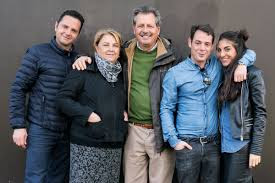 Indeed, present day Alghero is steeped in Catalan influence in its architecture, cuisine, and local dialect. In this region particularly known to produce wines of distinction is where passionate winemaker Luigi “Gino” Bardino and his family built their small estate to harness fresh maritime breezes and poor, rocky soils and transform them into high-quality wine.
Indeed, present day Alghero is steeped in Catalan influence in its architecture, cuisine, and local dialect. In this region particularly known to produce wines of distinction is where passionate winemaker Luigi “Gino” Bardino and his family built their small estate to harness fresh maritime breezes and poor, rocky soils and transform them into high-quality wine.
A banker by trade, Gino fled the stagnant office environment to devote his life to wine. After years of studying enology in his spare time he planted his own vineyards and established Vigne Rada. He chose only traditional grape varieties to the region, planting in two distinct terroirs: Monte Pedrosu, where the  winery is located, features sandy and clayey alluvial soils with abundant riverbed stones and quartz, while the sloping Cubalciada site is home to clay, limestone, and some chalk. Farming is sustainable, by hand, and with help from the whole family.
winery is located, features sandy and clayey alluvial soils with abundant riverbed stones and quartz, while the sloping Cubalciada site is home to clay, limestone, and some chalk. Farming is sustainable, by hand, and with help from the whole family.
The cuvée “Riviera” is 100% Cannonau fermented in stainless steel tank. 70% of the wine ages in stainless steel for 10 months, 30% ages in 225L and 500L oak tonneaux (no new oak) for three to four months and is then blended with the stainless steel until bottling one year after harvest. The result is a bright and pure island expression, with pretty aromatics of fresh-cut flowers, cherry candy, and dried coastal Mediterranean herbs. A sip is light on the palate yet filled with ripe fruit and a coiled, mineral finish perhaps not so surprisingly similar to many of the Corsican wines that we carry. Pour this on the patio with some lamb chops off the grill.
More Wines from Vigne Rada
All prices based on purchase of 6-pack (mix-and-match)
~$22 “Stria” (Vermentino di Sardegna 2016) White SOLD OUT
 100% Vermentino with aromatics of crunchy yellow orchard fruits and fronds of fennel. Fermentation takes place in stainless steel tank and the wine is then aged three to four months in stainless steel on fine lees with regularly stirring for a wine that is simultaneously dense and crisp.
100% Vermentino with aromatics of crunchy yellow orchard fruits and fronds of fennel. Fermentation takes place in stainless steel tank and the wine is then aged three to four months in stainless steel on fine lees with regularly stirring for a wine that is simultaneously dense and crisp.
~$31 “Arsenale” (Alghero Cagnulari 2015) Red SOLD OUT
 Although very much a Sardinian variety today, the Cagnulari vine was likely brought to the Island centuries ago by Catalan conquerors. Rich but not heavy with heady aromas of ripe fruit, mint, and grilled herbs a sip is both dense and juicy. Pair with a plump steak or huge, olive oil-soaked Cremini mushrooms off the grill. The wine ages in stainless steel tank for 12 months and then four to six months in 500L oak tonneaux (no new oak).
Although very much a Sardinian variety today, the Cagnulari vine was likely brought to the Island centuries ago by Catalan conquerors. Rich but not heavy with heady aromas of ripe fruit, mint, and grilled herbs a sip is both dense and juicy. Pair with a plump steak or huge, olive oil-soaked Cremini mushrooms off the grill. The wine ages in stainless steel tank for 12 months and then four to six months in 500L oak tonneaux (no new oak).
~$40 “3 Nodi” (Isola dei Nuraghi Passito Bianco 2016) White
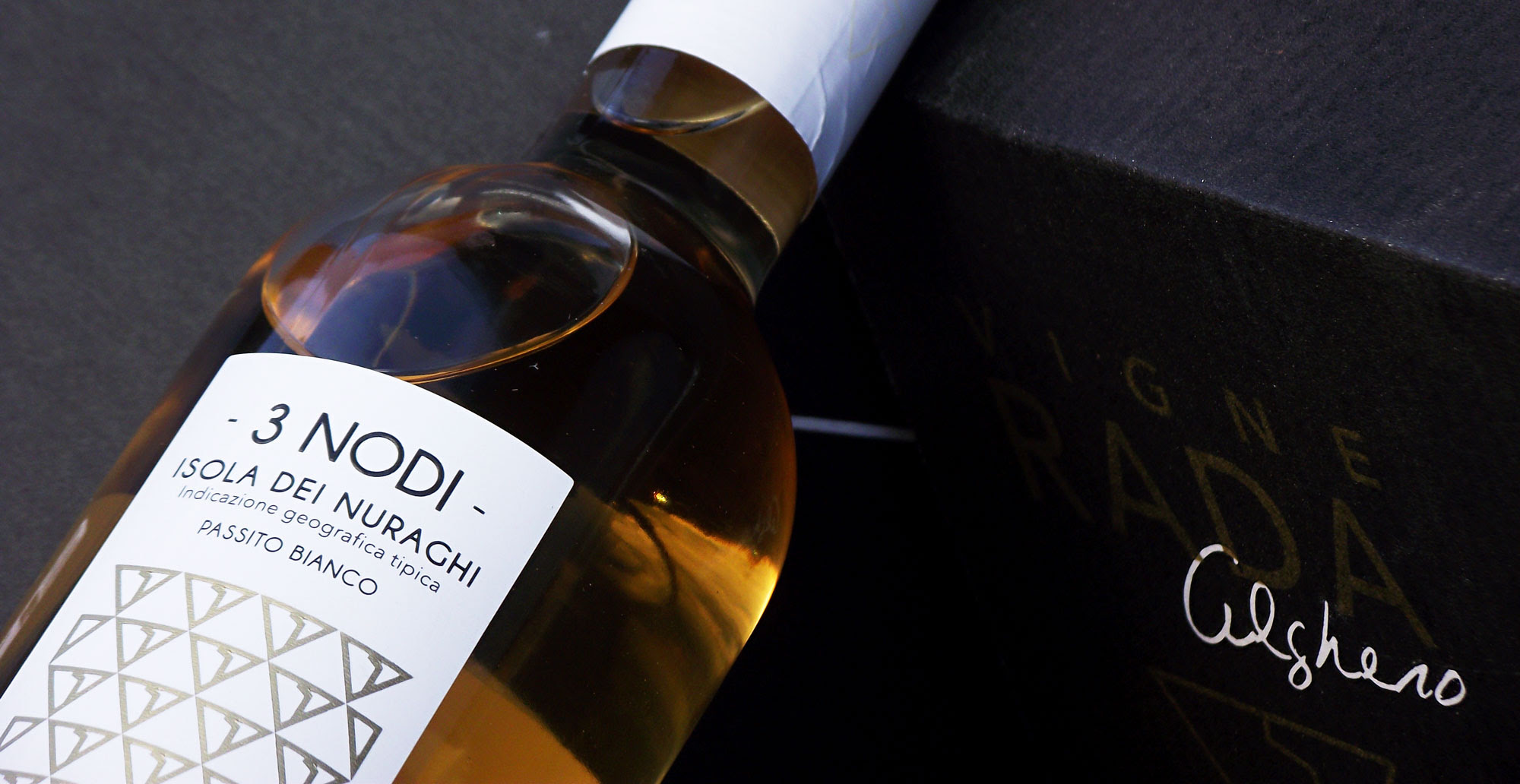 The Maestrale wind that cuts through the ideally exposed vineyards of Monte Pedrosu allows the Vermentino grapes to dry naturally on the vines. Botrytis develops on grapes before drying and harvest in mid-October. The result is a sweet and aromatically complex dessert wine, ideal for pairing with fat and salty cheeses.
The Maestrale wind that cuts through the ideally exposed vineyards of Monte Pedrosu allows the Vermentino grapes to dry naturally on the vines. Botrytis develops on grapes before drying and harvest in mid-October. The result is a sweet and aromatically complex dessert wine, ideal for pairing with fat and salty cheeses.
- - -
Posted on 2018.03.24 in Italy, Sardinia | Read more...
Domaine Bart – Brilliant (& Absurd Value) 2015 Vintage Burgundy from the Côte de Nuits
Domaine Bart Marsannay Red
Special Price: $151/6-pack (~$25/bottle) SOLD OUT
We are always talking about value and doing our best to offer world-class wines that are worth every cent. But every once in a while a wine comes along that is such a great value it even amazes us. Such is the case with Domaine Bart Marsannay.
 100% Pinot Noir from the northernmost appellation in the Côte d’Or, 2015 Domaine Bart Marsannay exudes heady aromas of floral cherry cream soda with a background of dry, dusty peat moss and after a while in the glass the practically indescribable yet quite specific aromatic expression of a Côte de Nuits red wine begins to emerge. A sip begins with jellied, fresh cranberry and cherry fruit in perfect balance with a slight mineral finish. Even the most basic red Burgundy quite often needs a little time to harmonize. Not so in this case. Indeed, this wine is drinking so well presently you might be shocked at how quickly a glass is joyously drained.
100% Pinot Noir from the northernmost appellation in the Côte d’Or, 2015 Domaine Bart Marsannay exudes heady aromas of floral cherry cream soda with a background of dry, dusty peat moss and after a while in the glass the practically indescribable yet quite specific aromatic expression of a Côte de Nuits red wine begins to emerge. A sip begins with jellied, fresh cranberry and cherry fruit in perfect balance with a slight mineral finish. Even the most basic red Burgundy quite often needs a little time to harmonize. Not so in this case. Indeed, this wine is drinking so well presently you might be shocked at how quickly a glass is joyously drained.
Regarding the 2015 vintage, Pierre Bart had this to say: “2015 gave us the cleanest harvest that I have ever seen and as such there was almost no sorting required beyond the odd leaf or insect here and there. I used between 20 and 50% whole clusters and the vinifications unfolded with very little intervention necessary. There wasn’t much malic acidity and the malos were practically finished before the vinifications were finished! As to the wines, they’re concentrated and serious and should age for years yet the velvety textures should allow them to drink well young too.”
But we discourage you to stuff 2015 Domaine Bart Marsannay in the cellar corner. It is a wine to drink through this summer with your best friends and a plate full of grilled, mature Cremini mushrooms drizzled in quality olive oil.
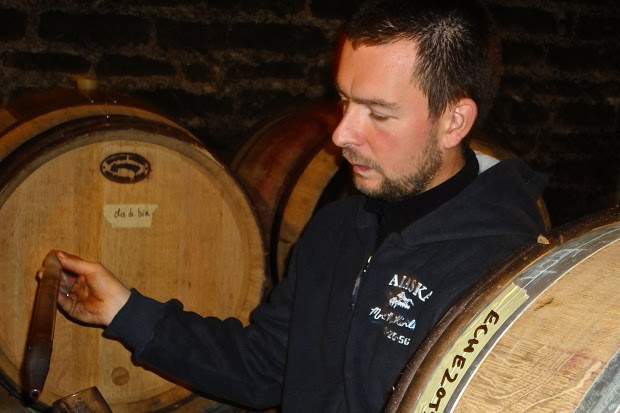 Pierre Bart is the sixth generation at Domaine Bart. Since 2009 he’s been running the 54 acre domaine along with his uncle, Martin. His grandmother comes from the same family as Domaine Bruno Clair, explaining why there are holdings in the Grand Crus of Bonnes-Mares and Chambertin-Clos de Bèze, as well as Santenay. Indeed, a good portion of the estate’s holdings come from the split of the renowned Domaine Claire-Daü between Domaine Bart and Domaine Bruno Clair (even another portion was sold off to Louis Jadot). Previous to the split, Domaine Claire-Daü was one of the most heralded and respected producers in the region, nearly singlehandedly bringing the appellation of Marsannay its current status.
Pierre Bart is the sixth generation at Domaine Bart. Since 2009 he’s been running the 54 acre domaine along with his uncle, Martin. His grandmother comes from the same family as Domaine Bruno Clair, explaining why there are holdings in the Grand Crus of Bonnes-Mares and Chambertin-Clos de Bèze, as well as Santenay. Indeed, a good portion of the estate’s holdings come from the split of the renowned Domaine Claire-Daü between Domaine Bart and Domaine Bruno Clair (even another portion was sold off to Louis Jadot). Previous to the split, Domaine Claire-Daü was one of the most heralded and respected producers in the region, nearly singlehandedly bringing the appellation of Marsannay its current status.
Pierre and Martin’s wines are balanced and classic Burgundy, understated with grace and elegance. It begins in the vineyard with sustainable and organic farming practices on every parcel. Each parcel is worked by hand according to its specific microclimate. The use of new oak is judicious and depends on the parcel. According to Pierre, “We make very fruity wines in classic style. The main words at our domaine are fruit and balance, balance between fruit, acidity and tannins. So we don’t produce big extracted wines. We try to respect the fruit.”
More 2015 Burgundy from Domaine Bart
All prices based on purchase of 6-pack (mix-and-match)
~$37 Les Favières (Marsannay 2015) White
A rare white Burgundy made entirely from 45 and 60-year-old vines of Chardonnay Musqué – a clone of Chardonnay with perfumed, Muscat-like characteristics.
~$34 “Les Echezots” (Marsannay 2015) Red
The Les Echezots vineyard gets more cool winds from the Hautes-Côtes. Subsequently the grapes ripen later there and it is always the last parcel to be harvested.
~$43 “Champs Salomon” (Marsannay 2015) Red
One of Domaine Bart’s best Marsannay vineyards is located in a prime spot on the mid-slope, producing wines which combine power with elegance and longevity.
~$62 “Les Hervelets” (Fixin, Premier Cru 2015) Red
One of the top vineyard parcels in Fixin. Dark fruits, hints of earth and spice, and a bit of heft from the more pronounced tannic structure allow this expression longer term aging potential.
$207 Bonnes Mares (Grand Cru 2015) Red
Domaine Bart’s Bonnes Mares parcels are next to those of Comte de Vogüe. It is a powerful, long-lived wine. Only ten barrels are produced.
$243 Chambertin Clos du Bèze (Grand Cru 2015) Red
Generally Clos de Bèze is considered to be more concentrated than Bonnes Mares but in the case of Domaine Bart’s parcels it’s the other way around. Expressive and intense, only five barrels are produced.
- - -
Posted on 2018.03.14 in France, Saturday Sips Wines, Burgundy | Read more...
Featured Wines
- Notebook: A’Boudt Town
- Saturday Sips Wines
- Saturday Sips Review Club
- The Champagne Society
- Wine-Aid Packages
Wine Regions
Grape Varieties
Aglianico, Albarino, Albarín Tinto, Albillo, Aleatico, Alicante Bouschet, Aligote, Altesse, Arcos, Aubun, Auxerrois, Barbarossa, Beaune, Biancu Gentile, Bonarda, bourboulenc, Cabernet Sauvignon, Caladoc, Carignan, Chablis, Chenin Blanc, Cinsault, Clairette, Cortese, Corvinone, Cot, Counoise, Dolcetto, Fiano, folle Blanche, Frappato, Fumin, Gamay, Garganega, Garnacha Tintorera, Godello, Graciano, Grenache, Grenache Blanc, Grolleau, Groppello, Jacquère, Lladoner Pelut, Maconnais, Malbec, Malvasia, Malvasia Nera, manseng, Marcelan, Marselan, Marzemino, Melon de Bourgogne, Mencía, Merlot, Mondeuse, Montepulciano, Montònega, Mourv, Mourvèdre, Muscadelle, Muscat, Natural, Nebbiolo, Nero d'Avola, Niellucciu, Palomino, Patrimonio, Pecorino, Pedro Ximénez, Persan, Petit Verdot, Pineau d'Aunis, Pinot Auxerrois, Pouilly Fuisse, Pouilly Loche, Poulsard, Riesling, Rondinella, Rose, Rousanne, Roussanne, Sagrantino, Sangiovese, Sauvignon, Sciacarellu, Serine, Souson, Sylvaner, Syrah, Tannat, Tempranillo, Teroldego, Timorasso, Treixadura, trepat, Trousseau, Ugni Blanc, Viognier, Viura, Xarel-loWines & Events by Date
- September 2025
- August 2025
- July 2025
- June 2025
- May 2025
- April 2025
- March 2025
- February 2025
- January 2025
- December 2024
- November 2024
- October 2024
- September 2024
- August 2024
- July 2024
- June 2024
- May 2024
- April 2024
- March 2024
- February 2024
- January 2024
- December 2023
- November 2023
- October 2023
- September 2023
- August 2023
- July 2023
- June 2023
- May 2023
- April 2023
- March 2023
- February 2023
- January 2023
- December 2022
- November 2022
- October 2022
- September 2022
- August 2022
- July 2022
- June 2022
- May 2022
- April 2022
- March 2022
- February 2022
- January 2022
- December 2021
- November 2021
- October 2021
- September 2021
- August 2021
- July 2021
- June 2021
- May 2021
- April 2021
- March 2021
- February 2021
- January 2021
- December 2020
- November 2020
- October 2020
- September 2020
- August 2020
- July 2020
- June 2020
- May 2020
- April 2020
- March 2020
- February 2020
- January 2020
- December 2019
- November 2019
- October 2019
- September 2019
- August 2019
- July 2019
- June 2019
- May 2019
- April 2019
- March 2019
- February 2019
- January 2019
- December 2018
- November 2018
- October 2018
- September 2018
- August 2018
- July 2018
- June 2018
- May 2018
- April 2018
- March 2018
- February 2018
- January 2018
- December 2017
- November 2017
- October 2017
- September 2017
- August 2017
- July 2017
- June 2017
- May 2017
- April 2017
- March 2017
- February 2017
- January 2017
- December 2016
- November 2016
- October 2016
- September 2016
- August 2016
- July 2016
- June 2016
- May 2016
- April 2016
- March 2016
- February 2016
- January 2016
- December 2015
- November 2015
- October 2015
- September 2015
- August 2015
- July 2015
- June 2015
- May 2015
- April 2015
- March 2015
- February 2015
- January 2015
- December 2014
- November 2014
- October 2014
- September 2014
- August 2014
- July 2014
- June 2014
- April 2014
- March 2014
- February 2014
- January 2014
- December 2013
- November 2013
- October 2013
- September 2013
- August 2013
- July 2013
- June 2013
- May 2013
- April 2013
- March 2013
- February 2013
- January 2013
- December 2012
- November 2012
- October 2012

